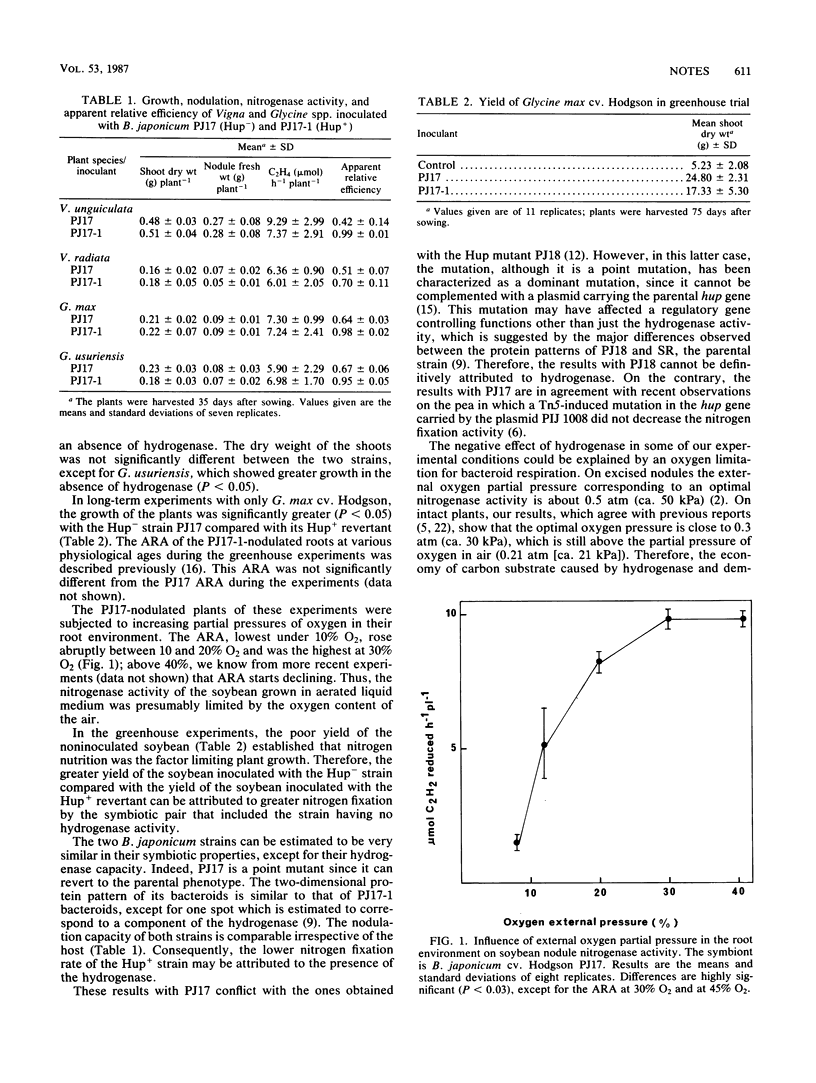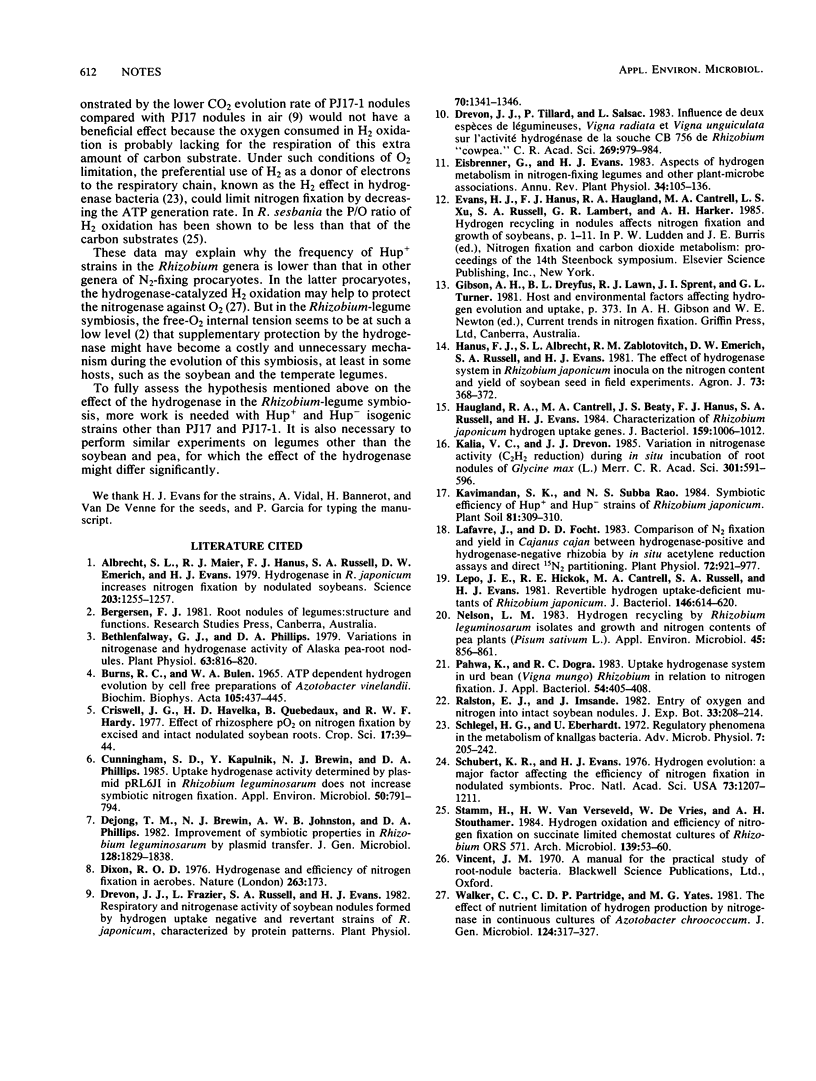Abstract
The effect of the Bradyrhizobium japonicum hydrogenase on nitrogen fixation was evaluated by comparing the growth of Vigna and Glycine species inoculated with a Hup mutant and its Hup+ revertant. In all experiments, the growth of plants inoculated with the strain without hydrogenase was at least equal to the growth of the strain with hydrogenase. For Glycine usuriensis and Glycine max cv. Hodgson in liquid culture, the growth was higher with the Hup− strain. It is possible that reduced rates of nitrogen fixation in the presence of hydrogenase are due to O2 depletion caused by the hydrogen oxidizing, since the oxygen pressure in the air appears to be a limiting factor of symbiotic nitrogen fixation in the soybean.
Full text
PDF


Selected References
These references are in PubMed. This may not be the complete list of references from this article.
- Albrecht S. L., Maier R. J., Hanus F. J., Russell S. A., Emerich D. W., Evans H. J. Hydrogenase in Rhizobium japonicum Increases Nitrogen Fixation by Nodulated Soybeans. Science. 1979 Mar 23;203(4386):1255–1257. doi: 10.1126/science.203.4386.1255. [DOI] [PubMed] [Google Scholar]
- Bethlenfalvay G. J., Phillips D. A. Variation in nitrogenase and hydrogenase activity of alaska pea root nodules. Plant Physiol. 1979 May;63(5):816–820. doi: 10.1104/pp.63.5.816. [DOI] [PMC free article] [PubMed] [Google Scholar]
- Burns R. C., Bulen W. A. ATP-dependent hydrogen evolution by cell-free preparations of Azotobacter vinelandii. Biochim Biophys Acta. 1965 Sep 20;105(3):437–445. doi: 10.1016/s0926-6593(65)80229-6. [DOI] [PubMed] [Google Scholar]
- Cunningham S. D., Kapulnik Y., Brewin N. J., Phillips D. A. Uptake Hydrogenase Activity Determined by Plasmid pRL6JI in Rhizobium leguminosarum Does Not Increase Symbiotic Nitrogen Fixation. Appl Environ Microbiol. 1985 Oct;50(4):791–794. doi: 10.1128/aem.50.4.791-794.1985. [DOI] [PMC free article] [PubMed] [Google Scholar]
- Drevon J. J., Frazier L., Russell S. A., Evans H. J. Respiratory and Nitrogenase Activities of Soybean Nodules Formed by Hydrogen Uptake Negative (Hup) Mutant and Revertant Strains of Rhizobium japonicum Characterized by Protein Patterns. Plant Physiol. 1982 Nov;70(5):1341–1346. doi: 10.1104/pp.70.5.1341. [DOI] [PMC free article] [PubMed] [Google Scholar]
- Haugland R. A., Cantrell M. A., Beaty J. S., Hanus F. J., Russell S. A., Evans H. J. Characterization of Rhizobium japonicum hydrogen uptake genes. J Bacteriol. 1984 Sep;159(3):1006–1012. doi: 10.1128/jb.159.3.1006-1012.1984. [DOI] [PMC free article] [PubMed] [Google Scholar]
- La Favre J. S., Focht D. D. Comparison of N(2) Fixation and Yields in Cajanus cajan between Hydrogenase-Positive and Hydrogenase-Negative Rhizobia by In Situ Acetylene Reduction Assays and Direct N Partitioning. Plant Physiol. 1983 Aug;72(4):971–977. doi: 10.1104/pp.72.4.971. [DOI] [PMC free article] [PubMed] [Google Scholar]
- Lepo J. E., Hickok R. E., Cantrell M. A., Russell S. A., Evans H. J. Revertible hydrogen uptake-deficient mutants of Rhizobium japonicum. J Bacteriol. 1981 May;146(2):614–620. doi: 10.1128/jb.146.2.614-620.1981. [DOI] [PMC free article] [PubMed] [Google Scholar]
- Nelson L. M. Hydrogen Recycling by Rhizobium leguminosarum Isolates and Growth and Nitrogen Contents of Pea Plants (Pisum sativum L.). Appl Environ Microbiol. 1983 Mar;45(3):856–861. doi: 10.1128/aem.45.3.856-861.1983. [DOI] [PMC free article] [PubMed] [Google Scholar]
- Schubert K. R., Evans H. J. Hydrogen evolution: A major factor affecting the efficiency of nitrogen fixation in nodulated symbionts. Proc Natl Acad Sci U S A. 1976 Apr;73(4):1207–1211. doi: 10.1073/pnas.73.4.1207. [DOI] [PMC free article] [PubMed] [Google Scholar]


